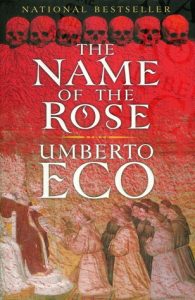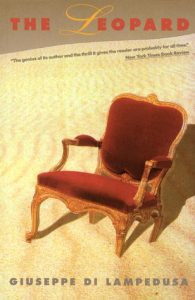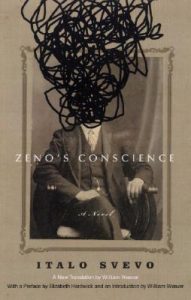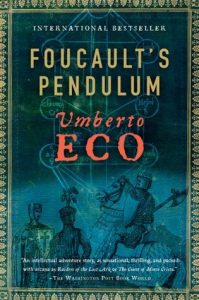By: Rachel Vadaj, ISDA Editor
Looking for the next book to dive into as you sip on your morning cappuccino or wait for your sauce to finish simmering?
Here are 19 famous novels by Italian authors to complete your summer reading list for 2019.
Many of the novels on this list were originally penned in the Italian language and translated into English years later, and some were even adapted for the big screen.
The Name of the Rose by Umberto Eco
The award-winning debut album for Eco is a murder mystery combined with biblical analysis, literary theory, medieval studies, and semiotics in fiction.
The 1980 novel was also turned into a movie featuring Sean Connery and Christian Slater in 1986. A television series based on the novel has also been created this year.
“The year is 1327. Benedictines in a wealthy Italian abbey are suspected of heresy, and Brother William of Baskerville arrives to investigate. When his delicate mission is suddenly overshadowed by seven bizarre deaths, Brother William turns detective. His tools are the logic of Aristotle, the theology of Aquinas, the empirical insights of Roger Bacon—all sharpened to a glistening edge by wry humor and a ferocious curiosity. He collects evidence, deciphers secret symbols and coded manuscripts, and digs into the eerie labyrinth of the abbey, where ‘the most interesting things happen at night.”
The Leopard by Giuseppe Tomasi di Lampedusa
Amazon describes the novel as, “Set in the 1860s, The Leopard tells the spellbinding story of a decadent, dying Sicilian aristocracy threatened by the approaching forces of democracy and revolution. The dramatic sweep and richness of observation, the seamless intertwining of public and private worlds, and the grasp of human frailty imbue The Leopard with its particular melancholy beauty and power, and place it among the greatest historical novels of our time.”
If on a Winter’s Night a Traveler by Italo Calvino
“If on a Winter’s Night a Traveler turns out to be not one novel but ten, each with a different plot, style, ambience, and author, and each interrupted at a moment of suspense. Together they form a labyrinth of literatures, known and unknown, alive and extinct, through which two readers, a male and a female, pursue both the story lines that intrigue them and one another.”
The Decameron by Giovanni Boccaccio
“Written in the middle of the 14th century as the Bubonic Plague decimated the population of Europe, “The Decameron” is a satirical and allegorical collection of stories by Italian author Giovanni Boccaccio. Constructed as a series of “frame stories,” or stories within a story, the narrative follows seven young women and three young men who take refuge in a secluded villa outside Florence in order to escape the Black Death. During ten evenings of their stay, each of travelers takes turns as storyteller to pass the time. Their stories relate tales of love, both happy and tragic, examples of the power of fortune and human will, and exhibitions of virtue, cleverness, and trickery. Boccaccio’s work is not only important for its superb literary quality but for its examination of the changing cultural values that defined the transition from medieval times into the renaissance. The virtues of intelligence and sophistication of the increasingly urbanized and mercantilist Europe are shown as superior to the relative simplicity and piousness of the feudal system. More than the sum of its parts, The Decameronis a milestone in the history of European literature, an influential and enduring masterpiece.”
Invisible Cities by Italo Calvino
Amazon describes the book as, “In a garden sit the aged Kublai Khan and the young Marco Polo — Mongol emperor and Venetian traveler. Kublai Khan has sensed the end of his empire coming soon. Marco Polo diverts his host with stories of the cities he has seen in his travels around the empire: cities and memory, cities and desire, cities and designs, cities and the dead, cities and the sky, trading cities, hidden cities. As Marco Polo unspools his tales, the emperor detects these fantastic places are more than they appear.”
Zeno’s Conscience by Italo Svevo
“Long hailed as a seminal work of modernism in the tradition of Joyce and Kafka, and now available in a supple new English translation, Italo Svevo’s charming and splendidly idiosyncratic novel conducts readers deep into one hilariously hyperactive and endlessly self-deluding mind. The mind in question belongs to Zeno Cosini, a neurotic Italian businessman who is writing his confessions at the behest of his psychiatrist. Here are Zeno’s interminable attempts to quit smoking, his courtship of the beautiful yet unresponsive Ada, his unexpected–and unexpectedly happy–marriage to Ada’s homely sister Augusta, and his affair with a shrill-voiced aspiring singer. Relating these misadventures with wry wit and a perspicacity at once unblinking and compassionate, Zeno’s Conscience is a miracle of psychological realism.”
The Betrothed by Alessandro Manzoni
“Considered one of the most important and widely read novels ever written in the Italian language, The Betrothed (I Promessi Sposi) is Alessandro Manzoni’s 1827 historical novel, which details the terribly oppressive rule of the Spanish over Italy in the early 1600s. At the center of the novel is the story of two young lovers, Renzo and Lucia, whose marriage is forbidden by the local baron, who wishes to wed the lovely Lucia himself. Forced to flee their homes, Renzo and Lucia are separated and must struggle against the ravages of war, famine, and the plague to be reunited again. While in essence a simple and affecting love story, The Betrothed is also a fascinating and detailed glimpse into a dramatic and tumultuous period in Italy’s history. Famed for its depiction of young love, devotion, and fidelity, the novel is also noted for its incredibly realistic depictions of the real-life plague that ravaged Milan, as well as the subsequent bread shortages and violent unrest. Manzoni’s The Betrothed is an epic Italian masterpiece.”
The Baron in the Trees by Italo Calvino
This “whimsical, imaginative story about life in the trees” surrounds “Cosimo, a young Italian nobleman of the eighteenth century, rebels against parental authority by climbing into the trees and remaining there for the rest of his life. He adapts efficiently to an arboreal existence – hunts, sows crops, plays games with earth-bound friends, fights forest fires, solves engineering problems, and even manages to have love affairs. From his perch in the trees, Cosimo sees the age of Voltaire pass by and a new century dawn.”
Foucault’s Pendulum by Umberto Eco
“Bored with their work, and after reading too many manuscripts about occult conspiracy theories, three vanity publisher employees (Belbo, Diotallevi and Casaubon) invent their own conspiracy for fun. They call this satirical intellectual game “The Plan,” a hoax that connects the medieval Knights Templar with other occult groups from ancient to modern times. This produces a map indicating the geographical point from which all the powers of the earth can be controlled—a point located in Paris, France, at Foucault’s Pendulum. But in a fateful turn the joke becomes all too real.
The three become increasingly obsessed with The Plan, and sometimes forget that it’s just a game. Worse still, other conspiracy theorists learn about The Plan, and take it seriously. Belbo finds himself the target of a real secret society that believes he possesses the key to the lost treasure of the Knights Templar.”
The Late Mattia Pascal by Luigi Pirandello
“Mattia Pascal endures a life of drudgery in a provincial town. Then, providentially, he discovers that he has been declared dead. Realizing he has a chance to start over, to do it right this time, he moves to a new city, adopts a new name, and a new course of life—only to find that this new existence is as insufferable as the old one. But when he returns to the world he left behind, it’s too late: his job is gone, his wife has remarried. Mattia Pascal’s fate is to live on as the ghost of the man he was.”
The Tartar Steppe by Dino Buzzati
“Often likened to Kafka’s The Castle, The Tartar Steppe is both a scathing critique of military life and a meditation on the human thirst for glory. It tells of young Giovanni Drogo, who is posted to a distant fort overlooking the vast Tartar steppe. Although not intending to stay, Giovanni suddenly finds that years have passed, as, almost without his noticing, he has come to share the others’ wait for a foreign invasion that never happens. Over time the fort is downgraded and Giovanni’s ambitions fade until the day the enemy begins massing on the desolate steppe…”
The Day of the Owl by Leonardo Sciascia
“A man is shot dead as he runs to catch the bus in the piazza of a small Sicilian town. Captain Bellodi, the detective on the case, is new to his job and determined to prove himself. Bellodi suspects the Mafia, and his suspicions grow when he finds himself up against an apparently unbreachable wall of silence. A surprise turn puts him on the track of a series of nasty crimes. But all the while Bellodi’s investigation is being carefully monitored by a host of observers, near and far. They share a single concern: to keep the truth from coming out.”
Pinocchio by Carlo Collodi
This list could not be complete without the beloved and most famous Italian children’s novel that that was created into an animated Disney classic in 1940.
Amazon describes Carlo Collodi’s original version as “Carlo Collodi’s original version, is an adventure-filled, menacing fairy tale with a moral. Made by the woodcarver Geppetto, the puppet Pinocchio dreams of becoming a real child. But his unrestrained curiosity, dishonesty, and selfishness put him in constant peril. As he journeys from the deceptive ‘Field of Miracles,’ where he plants gold coins to make them grow, to the land where lazy boys turn into donkeys, Pinocchio’s path is paved with mistakes, willfulness, and danger. And all the while his nose keeps growing bigger and bigger and bigger every time he tells a fib, so all the world can see what a liar he is…”
Sostiene Pereira by Antonio Tabucchi
This novel was also adapted for the big screen in 1995 called According to Pereira. The movie was filmed in Italian and released in the United States three years later.
“Lisbon, 1938. In a Europe haunted by the ghost of totalitarianism, a journalist who has been dedicated to the news pages all his life is put in charge of the culture section of a mediocre newspaper. In need of a collaborator, he calls the young man Monteiro Rossi. The intense relationships that build between Monteiro, the elderly journalist and Monteiros girlfriend Marta result in a personal crisis, inner growth and a painful dose of conscience that profoundly change Pereiras life.”
The Garden of the Finzi-Continis by Georgio Bassani
This classic Italian drama was adapted into an Academy Award winning movie in 1970. The movie was recorded in Italian as the original novel was written.
“A richly evocative and nostalgic depiction of prewar Italy. The narrator, a young middle-class Jew in the Italian city of Ferrara, has long been fascinated from afar by the Finzi-Continis, a wealthy and aristocratic Jewish family, and especially by their charming daughter Micol. But it is not until 1938 that he is invited behind the walls of their lavish estate, as local Jews begin to gather there to avoid the racial laws of the Fascists, and the garden of the Finzi-Continis becomes a sort of idyllic sanctuary in an increasingly brutal world. Years later after the war, the narrator returns in memory to his doomed relationship with the lovely Micol, and to the predicament that faced all the Ferrarese Jews, in this unforgettably wrenching portrait of a community about to be destroyed by the world outside the garden walls.”
My Brilliant Friend by Elena Ferrante
This pseudonymous author has penned four mega-popular Neopolitan novels that explore the complicated intensity of female friendship. My Brilliant Friendis the first of the series, as well as the first to be adapted to the small screen. In 2018, HBO released the eight-episode drama series that was filmed in Italian.
“The story begins in the 1950s in a poor but vibrant neighborhood on the outskirts of Naples. Growing up on these tough streets, the two girls learn to rely on each other ahead of anyone or anything else. As they grow – and as their paths repeatedly diverge and converge – Elena and Lila remain best friends whose respective destinies are reflected and refracted in the other. They are likewise the embodiments of a nation undergoing momentous change. Through the lives of these two women, Ferrante tells the story of a neighborhood, a city, and a country as it is transformed in ways that, in turn, also transform the relationship between her protagonists.”
Christ Stopped at Eboli: The Story of a Year by Carlo Levi
The novel published in 1945 was adapted into an engaging and immersive historical drama film over three decades later in 1979. The film was also shot on location in the region where the novel is set in the Italian language.
“It was to Lucania, a desolate land in southern Italy, that Carlo Levi―a doctor, painter, philosopher, and man of letters―was confined as a political prisoner because of his opposition to Italy’s Fascist government at the start of the Ethiopian war in 1935. While there, Levi reflected on the harsh landscape and its inhabitants, peasants who lived the same lives their ancestors had, constantly fearing black magic and the near presence of death. In so doing, Levi offered a starkly beautiful and moving account of a place and a people living outside the boundaries of progress and time.”
The Shape of Water (Inspector Montalbano, #1) by Andrea Camilleri
Not to be confused with the drama/thriller film with the same title released in 2017, this novel is first in this author’s wry, brilliantly compelling Sicilian crime series featuring Inspector Montalbano. Even though the book was first published in Italian, The New York Times Book Review said Andrea Camilleri’s “savagely funny police procedural proves that sardonic laughter is a sound that translates ever so smoothly into English.”
“Silvio Lupanello, a big-shot in Vigàta, is found dead in his car with his pants around his knees. The car happens to be parked in a part of town used by prostitutes and drug dealers, and as the news of his death spreads, the rumors begin. Enter Inspector Salvo Montalbano, Vigàta’s most respected detective. With his characteristic mix of humor, cynicism, compassion, and love of good food, Montalbano battles against the powerful and corrupt who are determined to block his path to the real killer.”
The Periodic Table by Primo Levi
Amazon said, “The Periodic Table is largely a memoir of the years before and after Primo Levi’s transportation from his native Italy to Auschwitz as an anti-Facist partisan and a Jew.
It recounts, in clear, precise, unfailingly beautiful prose, the story of the Piedmontese Jewish community from which Levi came, of his years as a student and young chemist at the inception of the Second World War, and of his investigations into the nature of the material world. As such, it provides crucial links and backgrounds, both personal and intellectual, in the tremendous project of remembrance that is Levi’s gift to posterity. But far from being a prologue to his experience of the Holocaust, Levi’s masterpiece represents his most impassioned response to the events that engulfed him.
The Periodic Table celebrates the pleasures of love and friendship and the search for meaning, and stands as a monument to those things in us that are capable of resisting and enduring in the face of tyranny.”
Join Sunday Supper, OrderISDA’s weekly e-newsletter, for the latest serving of all things Italian.
Make the pledge and become a member of Italian Sons and Daughters of America today!





















